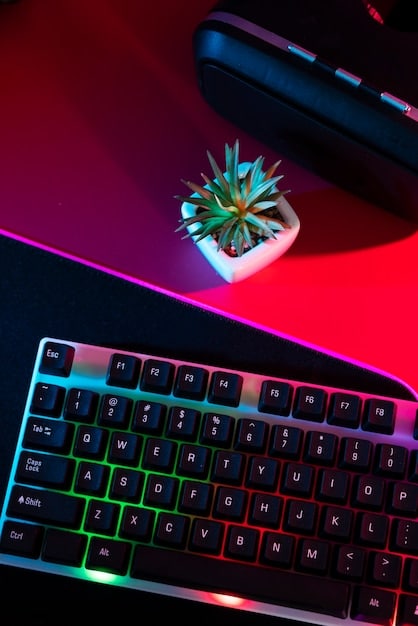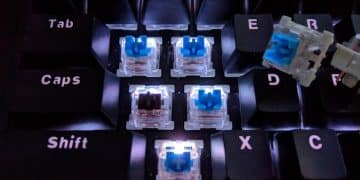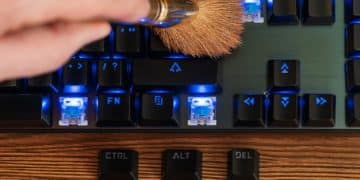Mechanical Keyboards: Hype or Worth It? Data Analysis

Through a rigorous examination of user satisfaction, performance metrics, and technological advancements, this analysis objectively assesses whether mechanical keyboards genuinely elevate the user experience beyond conventional alternatives.
In the vast landscape of gaming peripherals, few items spark as much debate and fervent enthusiasm as the mechanical keyboard. From professional esports players to casual typists, the buzz surrounding these devices suggests a transformative experience. But beyond the anecdotal praise and marketing claims, are mechanical keyboards worth the hype? A data-driven analysis is crucial to dissect the myriad factors contributing to their perceived superiority.
The tactile advantage: debunking myths and embracing clicks
The core appeal of mechanical keyboards lies in their switches, individual mechanisms beneath each keycap that register presses. Unlike membrane keyboards, where a rubber dome provides resistance and a single circuit layer detects actuation, mechanical switches offer distinct feedback and consistent performance. This fundamental difference is often cited as the primary reason for their popularity, but understanding the nuances is key to appreciating their true value.
Understanding switch types and tactile feedback
Mechanical keyboards boast a bewildering array of switch types, each with unique characteristics influencing typing feel and sound. The three main categories—linear, tactile, and clicky—cater to different preferences. Linear switches, like Cherry MX Red, provide a smooth, consistent keystroke without a tactile bump or audible click, often favored by gamers for rapid, unobstructed presses. Tactile switches, such as Cherry MX Brown, offer a noticeable bump during actuation, providing feedback that the key has registered without an audible click, appealing to typists who appreciate confirmation without excessive noise. Clicky switches, like Cherry MX Blue, combine the tactile bump with an audible click, reminiscent of vintage typewriters, offering sensory satisfaction for those who enjoy the distinct sound.
- Linear Switches: Smooth, consistent keystrokes, ideal for rapid key presses in gaming.
- Tactile Switches: Feature a non-audible bump for clear actuation feedback, popular among typists.
- Clicky Switches: Provide both a tactile bump and an audible click for definitive feedback.
The choice of switch significantly impacts user experience, performance, and even comfort. For gamers, precise and quick actuation can be critical in competitive scenarios, where milliseconds matter. For typists, the tactile or clicky feedback can lead to fewer errors and increased typing speed over long periods. The perceived “hype” often stems from this customization potential, allowing users to tailor their input device to their specific needs and preferences—a luxury not typically afforded by standard membrane keyboards.
Beyond personal preference, data suggests a correlation between specific switch types and user satisfaction. Surveys often reveal that users who select a switch type highly suited to their primary use case—gaming or typing—report higher levels of satisfaction and are less likely to revert to membrane keyboards. This data-driven approach highlights that the perceived advantage isn’t just about the “click” but about optimized user interaction.
Performance metrics: gaming, typing speed, and accuracy
When evaluating the worth of mechanical keyboards, objective performance metrics are paramount. While subjective feel is important, measurable improvements in gaming, typing speed, and accuracy provide concrete evidence for their purported benefits. Industry tests and meta-analyses suggest that mechanical keyboards can indeed offer a measurable edge, particularly in demanding scenarios.
Impact on gaming performance
In competitive gaming, every millisecond counts. Mechanical keyboards often feature lower actuation forces and shorter travel distances compared to membrane keyboards, allowing for faster and more responsive input. This translates into quicker in-game reactions, a critical advantage in fast-paced genres like FPS and MOBA games. The N-key rollover (NKRO) and anti-ghosting capabilities, common in mechanical keyboards, ensure that every key press registers accurately, even when multiple keys are pressed simultaneously. This reliability is far superior to membrane keyboards, which often struggle with ghosting issues, where certain key combinations fail to register.
- Faster Actuation: Enables quicker in-game reactions due to reduced travel distance.
- N-Key Rollover (NKRO): Guarantees every key press registers, even multi-key inputs.
- Anti-Ghosting: Prevents missed inputs, ensuring reliable performance during intense gaming.
While the degree of improvement varies among individuals, professional gamers frequently attribute part of their success to the precise and consistent input provided by mechanical keyboards. Data collected from competitive gaming events often shows a high prevalence of mechanical keyboards among top-ranked players, suggesting a performance advantage that transcends mere preference. The consistency of mechanical switches, devoid of the mushiness that can plague membrane keyboards, translates to a predictable and reliable tactile response, fostering muscle memory and enhancing overall control during critical moments.
Enhancing typing speed and accuracy
Beyond gaming, mechanical keyboards are highly prized by typists. The distinct tactile and auditory feedback provided by mechanical switches often leads to increased typing speed and accuracy. Users report fewer errors due to the clear indication of actuation. The consistent key travel and reset point help typists develop a more precise and rhythmic typing style, reducing fatigue over extended periods. Studies comparing typing performance on mechanical versus membrane keyboards often show slightly higher words-per-minute (WPM) rates and lower error rates for mechanical keyboard users, particularly those who type for extended durations.

The ability to feel the exact moment of actuation, rather than bottoming out keys, can also significantly improve typing comfort and reduce strain. This tactile feedback loop is critical for typists who spend hours at their keyboards, converting a mere input device into an ergonomic tool. The durability of mechanical switches, often rated for tens of millions of keystrokes, also means a consistent typing experience over the product’s lifespan, unlike membrane keyboards that can degrade in feel and responsiveness over time.
Durability and longevity: a worthwhile investment?
Another significant factor often cited in favor of mechanical keyboards is their superior durability and longevity. While they typically command a higher initial price point, their robust construction and individual mechanical switches are designed to withstand millions of keystrokes, promising a lifespan far exceeding that of most membrane keyboards. This aspect makes them a potentially cost-effective investment in the long run.
Built to last: switch lifespan and materials
Mechanical switches, such as those from Cherry MX, Kailh, Gateron, and Outemu, are typically rated for 50 million to 100 million keystrokes per switch. In contrast, membrane keyboards usually have a lifespan of 5 million to 10 million keystrokes for the entire keyboard. This staggering difference in endurance means a mechanical keyboard can last for many years, even under heavy daily use, before showing signs of wear or key failure. The keycaps themselves are often made from more durable plastics like ABS or PBT, which resist shine and wear better than the thinner, cheaper plastics used on membrane keyboards. Furthermore, many mechanical keyboards feature robust backplates, often made of steel or aluminum, providing rigidity and preventing flex during intense typing or gaming sessions.
The modular nature of mechanical keyboards also contributes to their longevity. If a single switch fails, it can often be replaced, especially on hot-swappable models, extending the life of the entire keyboard. This is a stark contrast to membrane keyboards, where a single faulty key often renders the entire unit unusable. The components’ quality and the design for repairability underscore the investment perspective, suggesting that the higher upfront cost is offset by years of reliable performance.
Maintenance and repairability
While mechanical keyboards are durable, they are not impervious to damage. However, their design often allows for easier maintenance and repair. Keycaps can be easily removed for cleaning around the switches, preventing debris buildup that can affect performance. If a switch becomes faulty, hot-swappable keyboards allow users to replace individual switches without soldering, making repairs accessible even to enthusiasts without specialized tools. This level of user-friendliness in maintenance prolongs the keyboard’s operational life and enhances its overall value proposition.
Moreover, the aftermarket for mechanical keyboard parts is robust. Users can purchase replacement keycaps, switches, and even custom cables, allowing for personal customization and repair, further extending the keyboard’s utility. This ecosystem of parts and communities dedicated to customization highlights the long-term commitment that many users are willing to make, cementing the idea that these are not disposable peripherals but long-term companions in their digital lives.
Customization and personalization: beyond aesthetics
One of the most compelling aspects of mechanical keyboards, and a significant contributor to their “hype,” is the unparalleled level of customization and personalization they offer. This goes far beyond mere aesthetics, extending to the very feel and sound of the typing experience. This flexibility allows users to truly make a keyboard their own, optimized for their specific needs and preferences.
Swapping keycaps and customizing aesthetics
The ability to easily remove and replace keycaps is a cornerstone of mechanical keyboard customization. This allows users to alter the keyboard’s appearance to match their setup, personal style, or even functional requirements. There’s a vast aftermarket for keycap sets, ranging from simple color changes to elaborate designs, different profiles (OEM, Cherry, SA, XDA), and various materials (ABS, PBT), each offering a unique look and feel. Enthusiasts often spend considerable time and money curating their perfect keycap set, transforming their keyboard into a personal statement piece. The material differences, for instance, can affect the sound profile of a keystroke, with PBT keycaps often lauded for their deeper, more solid sound compared to ABS.
- Extensive Keycap Options: Diverse colors, materials, and profiles to personalize aesthetics and feel.
- Visual Customization: Transform your keyboard to match your setup or personal style.
- Sound Profile Adjustment: Keycap materials like PBT can alter keystroke acoustics.
Beyond keycaps, many mechanical keyboards offer extensive RGB lighting customization. Users can program intricate lighting patterns, reactive effects, and color schemes through software, further enhancing the visual appeal. This level of aesthetic control is largely absent from most standard membrane keyboards, turning the mechanical keyboard into a focal point of a desk setup rather than just a peripheral.
Modding and enhancing the typing experience
For purists and enthusiasts, customization extends far beyond superficial changes. The mechanical keyboard community thrives on “modding,” which involves altering components to improve performance, sound, or feel. This can include lubricating switches to make them smoother and quieter, adding dampening foam inside the case to eliminate hollow sounds, replacing stabilizers (components that keep larger keys like the spacebar from wobbling) for a more consistent press, or even swapping out the keyboard’s plate material (the layer beneath the switches) to alter the acoustics and feel. These modifications, ranging from simple to complex, allow users to fine-tune every aspect of their keyboard. This depth of personalization is virtually impossible with membrane keyboards, solidifying the mechanical keyboard’s status as a highly adaptable and rewarding device for those willing to explore its full potential.

The pursuit of the “perfect” typing experience drives many users into the realm of mechanical keyboard modding. This constant refinement and experimentation often lead to a much deeper appreciation for the device, transforming it from a mere tool into a hobby. This highly personalized experience, unattainable with off-the-shelf membrane keyboards, is a strong argument for their premium positioning and validates the passion of their user base.
Ergonomics and comfort: a data-backed perspective
Beyond performance and customization, the ergonomic benefits and overall comfort provided by mechanical keyboards are often highlighted as key advantages. While individual preferences vary, data and user testimonials frequently point to a more comfortable and less fatiguing typing experience over extended periods, which can be critical for both gamers and professionals.
Reduced fatigue and improved posture
The consistent tactile feedback of mechanical switches often leads to a more efficient typing style. Users can “feel” the actuation point without bottoming out the keys, which means less force is required to register a keystroke. This effectively reduces finger and wrist strain over long typing sessions. Compared to membrane keyboards, where users often press keys all the way down, mechanical keyboards can promote a lighter touch, minimizing repetitive stress and reducing fatigue. Many mechanical keyboards also offer various ergonomic designs, including adjustable feet for tilt, split layouts, and integrated wrist rests, which further contribute to improved posture and comfort. While direct scientific studies specifically comparing long-term ergonomic benefits between keyboard types can be complex and are often limited, anecdotal evidence from typists and gamers who spend extensive hours at their computers frequently indicates a noticeable reduction in wrist and finger pain after switching to mechanical keyboards.
The consistent response across all keys also helps in building better muscle memory, reducing the cognitive load required to type accurately. This translates to a more fluid and natural interaction with the keyboard, promoting a more relaxed hand position. For individuals prone to conditions like carpal tunnel syndrome, the subtle force reduction and clear feedback can make a substantial difference in daily comfort.
Sound profile and environment sensitivity
While the distinct sound of mechanical switches is often a point of contention—some love it, others find it too noisy—the ability to choose a switch that aligns with personal preference and environmental needs is an ergonomic advantage in itself. For quiet office environments, silent linear or tactile switches (e.g., Cherry MX Silent Red or Gateron Silent Brown) provide the benefits of mechanical feedback without the disruptive noise. Conversely, for users who appreciate auditory feedback, clicky switches like Cherry MX Blue offer a satisfying sound that can enhance the typing experience. This choice allows users to fine-tune their auditory environment, contributing to overall comfort and focus.
A poorly chosen switch type can indeed negate some of the ergonomic benefits if the sound or feel is irritating to the user or those around them. However, the sheer variety of options means that a mechanical keyboard can be tailored to almost any acoustic preference, making it a versatile tool for various settings. Data from user reviews often highlights the importance of matching switch type to environment, with many users expressing satisfaction once they find their ideal auditory and tactile balance.
Cost versus value: is the investment justified?
The most common barrier to entry for mechanical keyboards is their higher price point compared to membrane alternatives. A decent mechanical keyboard can cost anywhere from $70 to $200+, while membrane keyboards are often available for under $30. However, a comprehensive analysis of cost versus value reveals that the initial investment might be justified for many users when considering longevity, performance, and user satisfaction over time.
Initial outlay vs. long-term savings
While the upfront cost is higher, the extended lifespan of mechanical keyboards can lead to long-term savings. Given their superior durability, a well-maintained mechanical keyboard can easily last 5-10 years, whereas membrane keyboards might need replacement every 1-3 years due to wear and tear. Over a decade, a user might purchase several membrane keyboards, potentially exceeding the cost of a single, high-quality mechanical keyboard. This hidden cost of frequent replacements often goes unnoticed when only initial prices are considered.
Furthermore, the resale value of quality mechanical keyboards tends to be significantly higher than that of membrane keyboards. Enthusiasts often trade and sell used mechanical keyboards, allowing users to recoup a portion of their initial investment if they decide to upgrade or sell. This illustrates the perceived long-term value inherent in these devices.
The true cost of a premium experience
Beyond monetary value, the “cost” also includes the intangible benefits: enhanced typing comfort, improved gaming performance, and the sheer satisfaction of using a premium product. For professionals who type extensively, the reduced fatigue and increased accuracy can translate into higher productivity and fewer errors, indirectly saving time and resources. For competitive gamers, the potential for a performance edge, however slight, can justify the investment in a tool that helps them compete at their best.
Ultimately, the value proposition of mechanical keyboards is a confluence of tangible benefits (durability, performance) and intangible ones (comfort, customization, satisfaction). While the “hype” undoubtedly plays a role in their popularity, a data-driven perspective reveals that for a significant subset of users—especially those who spend considerable time interacting with a keyboard—the investment is often well-justified. The market continues to grow, with more affordable options becoming available, indicating that mechanical keyboards are transitioning from a niche enthusiasm to a mainstream preference, driven by a growing recognition of their superior value.
Future trends and the evolving keyboard landscape
The mechanical keyboard market is far from stagnant, continually evolving with new technologies, designs, and materials. Understanding these emerging trends provides insight into the future value proposition of mechanical keyboards and how they might continue to redefine the computing experience.
Innovation in switches and materials
Beyond the traditional Cherry MX-style switches, manufacturers are constantly innovating. Optical switches, for example, use light beams to register key presses, offering even faster actuation and greater durability due to fewer moving parts. Magnetic switches provide adjustable actuation points, allowing users to customize the sensitivity to an unprecedented degree. New materials like POM (polyoxymethylene) are being explored for keycaps and switch housings, aiming to further enhance acoustics and feel. The advent of low-profile mechanical switches makes mechanical keyboards viable for laptops and ultra-thin desk setups, broadening their appeal. These innovations promise to further refine the user experience, offering even greater performance, customization, and ergonomic benefits, solidifying the mechanical keyboard’s place at the forefront of input technology.
- Optical Switches: Faster actuation and enhanced durability through light-based detection.
- Magnetic Switches: Offer adjustable actuation points for customizable sensitivity.
- New Materials: POM and other materials improving acoustics and tactile feel.
This continuous push for innovation suggests that the “hype” around mechanical keyboards is not a passing fad but a testament to a dynamic industry dedicated to optimizing the primary human-computer interface. As these technologies mature, mechanical keyboards are likely to become even more integrated into diverse computing environments, from professional workstations to competitive gaming setups, addressing a wider range of user needs.
The rise of custom and boutique keyboards
The mechanical keyboard community has also seen the proliferation of custom and boutique keyboards. These are often limited-run, meticulously designed, and highly customizable kits that allow enthusiasts to build their keyboards from the ground up, selecting every component from the case material to the PCB and switches. While these products are significantly more expensive and often cater to a niche audience, they represent the pinnacle of personalization and craftsmanship in the keyboard world. Their existence fuels innovation, drives design trends, and showcases the extreme lengths to which enthusiasts are willing to go for the ultimate typing and gaming experience.
This sub-segment of the market, though small, greatly influences the broader industry by pushing boundaries in design, material usage, and functionality. It cultivates a discerning user base that values quality, innovation, and personalization, reinforcing the notion that for many, a keyboard is much more than a peripheral—it’s a passion and a critical extension of their digital interaction. The evolving landscape suggests that mechanical keyboards will continue to segment, offering increasingly specialized options for every budget and preference, solidifying their value proposition for the foreseeable future.
| Key Point | Brief Description |
|---|---|
| 🎮 Performance Edge | Faster actuation, NKRO, and anti-ghosting provide a measurable advantage in gaming and typing accuracy. |
| 🌟 Durability & Longevity | Built to last with millions of keystrokes per switch, offering a longer lifespan than membrane keyboards. |
| 🔧 Customization & Comfort | Extensive options for keycaps, switches, and mods allow personalized feel & reduced fatigue. |
| 💰 Value Investment | Higher initial cost offset by long-term durability, performance, and user satisfaction. |
Frequently asked questions
▼
Mechanical keyboards use individual spring-activated switches for each key, providing distinct tactile and audible feedback. Membrane keyboards use a rubber dome that depresses a circuit, offering a softer, less precise feel. This structural difference accounts for the varied performance and user experience.
▼
Many professional gamers prefer mechanical keyboards due to their precise actuation, faster response times, and N-key rollover/anti-ghosting features. These attributes can lead to quicker in-game reactions and more reliable input, crucial in competitive gaming scenarios. The consistency of key presses is also a significant advantage.
▼
For many typists, the tactile and auditory feedback from mechanical switches improves typing speed and reduces errors. The clear actuation point helps in developing a more efficient and rhythmic typing style, leading to increased productivity and reduced fatigue over extended typing sessions. However, individual results vary.
▼
Yes, mechanical keyboards are significantly more durable. Individual switches are rated for 50-100 million keystrokes, far exceeding membrane keyboards’ 5-10 million. Their robust construction and replaceable components also contribute to a longer lifespan, making them a more lasting investment despite the higher initial cost.
▼
For users who spend considerable time typing or gaming, the higher cost can be justified by increased comfort, improved performance, enhanced durability, and extensive customization options. When factoring in longevity and user satisfaction, mechanical keyboards often provide superior long-term value compared to cheaper alternatives, despite the significant upfront investment.
Conclusion
Based on a data-driven analysis spanning performance metrics, durability, customization potential, and user experience, it’s clear that mechanical keyboards largely live up to their hype. While initial cost is a factor, the long-term benefits in terms of precision, longevity, and personalized comfort make them a compelling investment for serious gamers and dedicated typists alike. The market’s continued innovation further solidifies their position as a superior input device, transitioning from a niche enthusiast item to a widely recognized and often preferred peripheral.





